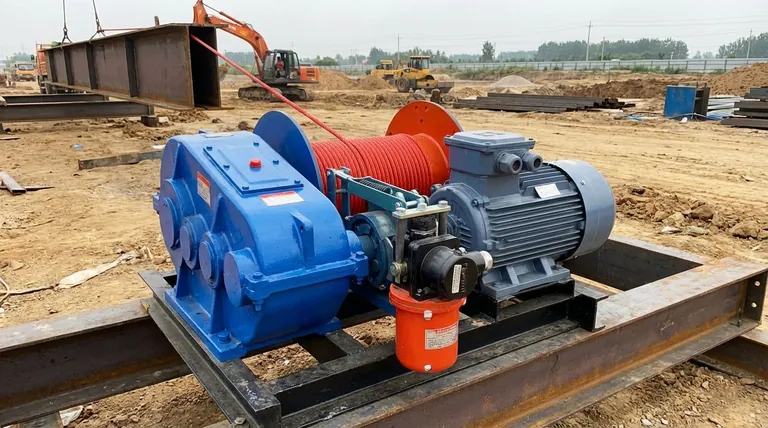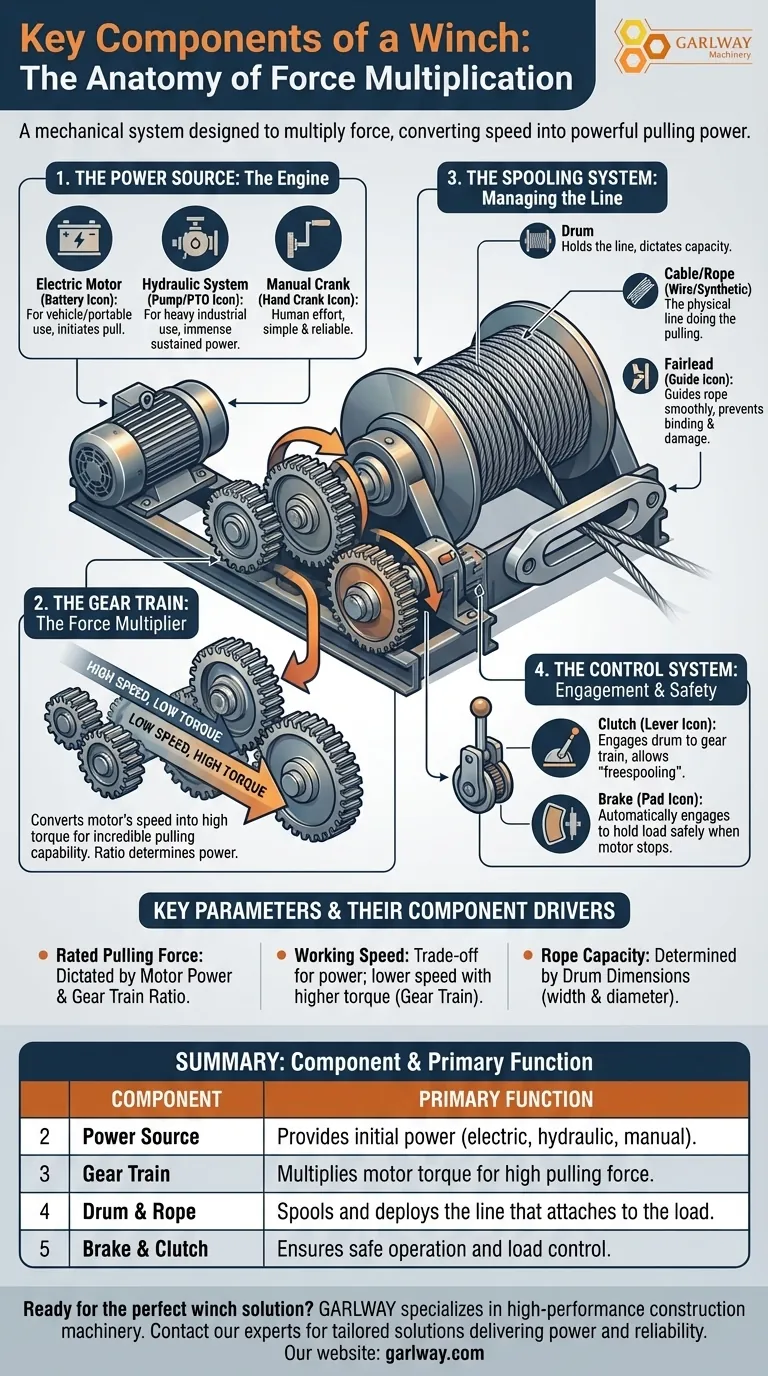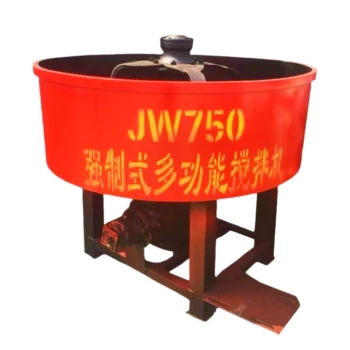At its core, a winch is a mechanical system designed to multiply force. It consists of a motor or crank that provides initial power, a gear train to increase torque, a drum to spool the wire or rope, and a braking system to safely manage the load. These components work in concert to pull heavy objects that would otherwise be impossible to move.
A winch is not just a motor and a rope; it's a complete system for converting speed into powerful pulling force. Understanding how each component contributes to this conversion is the key to selecting and operating a winch safely and effectively.

The Anatomy of a Winch: How Each Part Contributes
To truly grasp how a winch functions, we must look at its components not as a simple list of parts, but as a series of interconnected systems, each with a specific job.
The Power Source: The Engine of the Operation
The entire operation begins with a power source. The type of source defines the winch's primary category and application.
An electric motor is the most common power source for vehicle-mounted and many portable winches. It draws power from a battery to initiate the pull.
For heavy industrial applications, hydraulic systems are often used. These require a power take-off (PTO), hydraulic pumps, and valves to drive a hydromotor, providing immense and sustained pulling power.
A manual crank is the power source for a hand winch, relying on human effort. This simple, reliable design is ideal for situations where no electrical or hydraulic power is available.
The Gear Train: The Force Multiplier
The motor alone does not have enough torque to pull a heavy load. This is the critical role of the gear train, also known as the reduction gear mechanism.
The gear train takes the high speed and low torque from the motor and converts it into low speed and high torque. This multiplication of force is what gives the winch its incredible pulling capability. The specific gear ratio determines the winch's pulling power and line speed.
The Spooling System: Managing the Line
This system is responsible for holding, guiding, and deploying the line that attaches to the load.
The drum is the cylinder that the rope or cable winds onto. Its size dictates the winch's total rope capacity.
The cable or rope is the physical line that does the pulling. It can be made of steel wire for durability and abrasion resistance or synthetic rope for lighter weight and improved safety.
The fairlead is a crucial guide mounted to the winch or bumper. It prevents the cable from binding and ensures it spools smoothly and evenly onto the drum, which is vital for preventing damage to the rope and the winch itself.
The Control System: Engagement and Safety
These components allow you to operate the winch and ensure it performs its job safely.
The clutch allows you to engage or disengage the drum from the gear train. When disengaged, the drum can spin freely (a state called "freespooling"), allowing you to pull the line out by hand quickly.
The brake is a critical safety feature. It automatically engages when the motor stops, preventing the drum from releasing the line. This is essential for holding a heavy load securely in place without constant power from the motor.
Key Parameters Dictated by Components
The design and quality of these individual components directly determine the winch's performance specifications. Understanding this link helps you move beyond a simple parts list to a true understanding of the machine's capabilities.
Rated Pulling Force
This is the maximum load the winch can safely pull. It is a direct result of the motor's power combined with the force multiplication provided by the gear train's ratio. A more powerful motor or a higher gear ratio results in a higher rated pull.
Working Speed
This refers to how fast the winch can pull in its line under load. Speed is the primary trade-off for power; a winch with a very high pulling force (thanks to its gear train) will typically have a slower line speed.
Rope Capacity
This is simply the length of rope or cable the winch can hold. It is determined entirely by the physical dimensions—both the width and diameter—of the drum.
Making the Right Choice for Your Goal
By understanding how these components form a system, you can select the right winch for your specific needs.
- If your primary focus is vehicle recovery: You need a powerful electric motor, a robust gear train for maximum pull, and an absolutely reliable automatic brake.
- If your primary focus is workshop or manual lifting: A hand winch with a suitable gear ratio for manageable effort and a solid brake mechanism offers simplicity and reliability.
- If your primary focus is heavy, continuous industrial use: A hydraulic system is necessary for its sustained power output, durability, and heat management capabilities.
Ultimately, a winch is a system where the whole is greater than the sum of its parts.
Summary Table:
| Component | Primary Function |
|---|---|
| Power Source | Provides initial power (electric, hydraulic, or manual). |
| Gear Train | Multiplies motor torque for high pulling force. |
| Drum & Rope | Spools and deploys the line that attaches to the load. |
| Brake & Clutch | Ensures safe operation and load control. |
Ready to select the perfect winch for your project? The right components are critical for performance and safety. GARLWAY specializes in high-performance construction machinery, offering durable winches, concrete mixers, and batching plants trusted by construction companies and contractors globally. Contact our experts today to discuss your specific needs and get a tailored solution that delivers the power and reliability you require.
Visual Guide

Related Products
- Electric and Hydraulic Winch for Heavy Duty Applications
- Warn Winch Windlass Boat Trailer Winch
- Electric 120V Boat Winch by Badlands
- Best 18000 Pound Drum Anchor Trailer Winch
- 12000 lb Heavy Duty Electric Boat Winch
People Also Ask
- What is the difference between electric winch and electric hoist? Essential Safety & Application Guide
- How long can you run an electric winch? Master Safe, Efficient Vehicle Recovery
- How to power an electric winch on a trailer? Choose the Best Method for Your Setup
- How does the electric winch work? Unlock the Power of Force Multiplication
- How do I choose an electric winch? A guide to safe and effective pulling power.



















